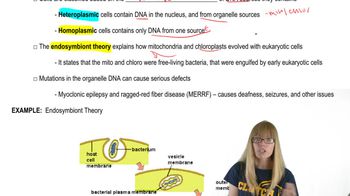(a) In humans the mitochondrial genome encodes a low number of proteins, rRNAs, and tRNAs but imports approximately 1100 proteins encoded by the nuclear genome. Yet, with such a small proportion from the mitochondrial genome encoding proteins and RNAs, a disproportionately high number of genetic disorders due to mtDNA mutations have been identified [Bigger, B. et al. (1999)]. What inheritance pattern would you expect in a three-generation pedigree in which the grandfather expresses the initial mtDNA defect? What inheritance pattern would you expect in a three-generation pedigree in which the grandmother expresses the initial mtDNA defect? (b) Considering the description in part (a) above, how would your pedigrees change if you knew that the mutation that caused the mitochondrial defect was recessive and located in the nuclear genome, was successfully transported into mitochondria, and negated a physiologically important mitochondrial function?
Table of contents
- 1. Introduction to Genetics51m
- 2. Mendel's Laws of Inheritance3h 37m
- 3. Extensions to Mendelian Inheritance2h 41m
- 4. Genetic Mapping and Linkage2h 28m
- 5. Genetics of Bacteria and Viruses1h 21m
- 6. Chromosomal Variation1h 48m
- 7. DNA and Chromosome Structure56m
- 8. DNA Replication1h 10m
- 9. Mitosis and Meiosis1h 34m
- 10. Transcription1h 0m
- 11. Translation58m
- 12. Gene Regulation in Prokaryotes1h 19m
- 13. Gene Regulation in Eukaryotes44m
- 14. Genetic Control of Development44m
- 15. Genomes and Genomics1h 50m
- 16. Transposable Elements47m
- 17. Mutation, Repair, and Recombination1h 6m
- 18. Molecular Genetic Tools19m
- 19. Cancer Genetics29m
- 20. Quantitative Genetics1h 26m
- 21. Population Genetics50m
- 22. Evolutionary Genetics29m
2. Mendel's Laws of Inheritance
Pedigrees
Problem 19
Textbook Question
Researchers examined a family with an interesting distribution of Leigh syndrome symptoms. In this disorder, individuals may show a progressive loss of motor function (ataxia, A) with peripheral neuropathy (PN, meaning impairment of the peripheral nerves). A mitochondrial DNA (mtDNA) mutation that reduces ATPase activity was identified in various tissues of affected individuals. The accompanying table summarizes the presence of symptoms in an extended family.
Person Condition Percent Mitochondria with
Mutation
Proband A and PN >90%
Brother A and PN >90%
Brother Asymptomatic 17%
Mother PN 86%
Maternal uncle PN 85%
Maternal cousin A and PN 90%
Maternal cousin A and PN 91%
Maternal Asymptomatic 56%
grandmother
How can some individuals in the same family show such variation in symptoms? What term, as related to organelle heredity, describes such variation?
 Verified step by step guidance
Verified step by step guidance1
Understand that the problem involves mitochondrial DNA (mtDNA), which is inherited maternally and can exhibit variability in symptoms among family members due to differences in the proportion of mutated mtDNA.
Recognize that the term describing this variation in symptoms is 'heteroplasmy,' which refers to the coexistence of both normal and mutated mtDNA within the same cell or organism.
Note that the severity of symptoms in mitochondrial disorders like Leigh syndrome is often correlated with the percentage of mutated mtDNA present in an individual's cells. For example, individuals with >90% mutated mtDNA (proband and brother) show severe symptoms, while those with lower percentages (e.g., 17% in the asymptomatic brother) may not exhibit symptoms.
Explain that heteroplasmy arises because mitochondria are distributed randomly during cell division, leading to variable proportions of mutated mtDNA in different tissues and individuals. This random distribution can result in a wide range of symptom severity within the same family.
Conclude that the variation in symptoms among family members is due to heteroplasmy and the threshold effect, where a certain proportion of mutated mtDNA must be exceeded for symptoms to manifest. This explains why some individuals are asymptomatic while others are severely affected.
 Verified video answer for a similar problem:
Verified video answer for a similar problem:This video solution was recommended by our tutors as helpful for the problem above
Video duration:
3mPlay a video:
Was this helpful?
Key Concepts
Here are the essential concepts you must grasp in order to answer the question correctly.
Mitochondrial Inheritance
Mitochondrial inheritance refers to the transmission of genetic material found in mitochondria, which is inherited exclusively from the mother. This type of inheritance can lead to variable expression of mitochondrial disorders, as seen in Leigh syndrome, where different individuals may exhibit varying symptoms despite sharing the same mtDNA mutation. The severity of symptoms can depend on the proportion of mutated mitochondria present in different tissues.
Recommended video:
Guided course

Organelle Inheritance
Heteroplasmy
Heteroplasmy is the presence of a mixture of more than one type of mitochondrial DNA within a cell or individual. In the context of mitochondrial diseases, such as Leigh syndrome, individuals may have varying levels of mutated mtDNA, leading to differences in symptom severity. This variation can explain why some family members are symptomatic while others remain asymptomatic, depending on the percentage of mutated mitochondria in their cells.
Recommended video:
Guided course

Organelle DNA Characteristics
Penetrance and Expressivity
Penetrance refers to the proportion of individuals with a specific genotype that actually express the associated phenotype, while expressivity describes the degree to which a genotype is expressed in an individual. In the case of Leigh syndrome, the differences in symptoms among family members can be attributed to incomplete penetrance and variable expressivity of the mitochondrial mutation, resulting in a range of clinical manifestations from severe symptoms to asymptomatic individuals.
Recommended video:
Guided course

Penetrance and Expressivity
Related Videos
Related Practice
Textbook Question
579
views


